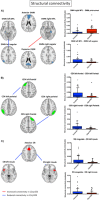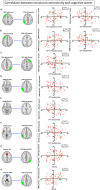Multimodal investigation of triple network connectivity in patients with 22q11DS and association with executive functions
- PMID: 28117515
- PMCID: PMC6866915
- DOI: 10.1002/hbm.23512
Multimodal investigation of triple network connectivity in patients with 22q11DS and association with executive functions
Abstract
Large-scale brain networks play a prominent role in cognitive abilities and their activity is impaired in psychiatric disorders, such as schizophrenia. Patients with 22q11.2 deletion syndrome (22q11DS) are at high risk of developing schizophrenia and present similar cognitive impairments, including executive functions deficits. Thus, 22q11DS represents a model for the study of neural biomarkers associated with schizophrenia. In this study, we investigated structural and functional connectivity within and between the Default Mode (DMN), the Central Executive (CEN), and the Saliency network (SN) in 22q11DS using resting-state fMRI and DTI. Furthermore, we investigated if triple network impairments were related to executive dysfunctions or the presence of psychotic symptoms. Sixty-three patients with 22q11DS and sixty-eighty controls (age 6-33 years) were included in the study. Structural connectivity between main nodes of DMN, CEN, and SN was computed using probabilistic tractography. Functional connectivity was computed as the partial correlation between the time courses extracted from each node. Structural and functional connectivity measures were then correlated to executive functions and psychotic symptom scores. Our results showed mainly reduced structural connectivity within the CEN, DMN, and SN, in patients with 22q11DS compared with controls as well as reduced between-network connectivity. Functional connectivity appeared to be more preserved, with impairments being evident only within the DMN. Structural connectivity impairments were also related to executive dysfunctions. These findings show an association between triple network structural alterations and executive deficits in patients with the microdeletion, suggesting that 22q11DS and schizophrenia share common psychopathological mechanisms. Hum Brain Mapp 38:2177-2189, 2017. © 2017 Wiley Periodicals, Inc.
Keywords: DTI; cognitive functions; large-scale networks; psychotic symptoms; resting-state fMRI; schizophrenia.
© 2017 Wiley Periodicals, Inc.
Figures



References
-
- Antshel KM, Fremont W, Kates WR (2008): The neurocognitive phenotype in velo‐cardio‐facial syndrome: A developmental perspective. Dev Disabil Res Rev 14:43–51. - PubMed
-
- Ashburner J (2007): A fast diffeomorphic image registration algorithm. NeuroImage 38:95–113. - PubMed
-
- Azuma R, Daly EM, Campbell LE, Stevens AF, Deeley Q, Giampietro V, Brammer MJ, Glaser B, Ambery FZ, Morris RG, Williams SCR, Owen MJ, Murphy DGM, Murphy KC (2009): Visuospatial working memory in children and adolescents with 22q11.2 deletion syndrome; an fMRI study. J Neurodev Disord 1:46–60. - PMC - PubMed
-
- Baker KD, Skuse DH (2005): Adolescents and young adults with 22q11 deletion syndrome: Psychopathology in an at‐risk group. Br J Psychiatry J Ment Sci 186:115–120. - PubMed
Publication types
MeSH terms
Substances
Supplementary concepts
LinkOut - more resources
Full Text Sources
Other Literature Sources

